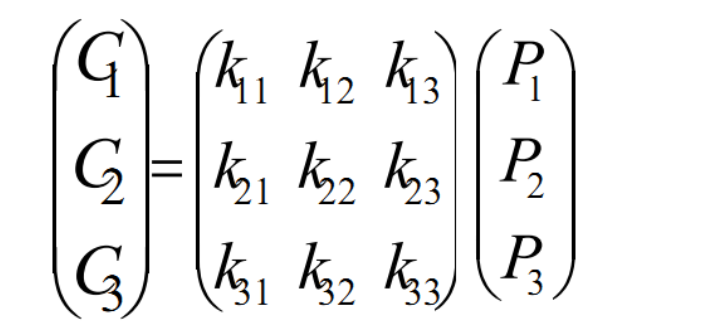1
2
3
4
5
6
7
8
9
10
11
12
13
14
15
16
17
18
19
20
21
22
23
24
25
26
27
28
29
30
31
32
33
34
35
36
37
38
39
40
41
42
43
44
45
46
47
48
49
50
51
52
53
54
55
56
57
58
59
60
61
62
63
64
65
66
67
68
69
70
71
72
73
74
75
76
77
78
79
80
81
82
83
84
85
86
87
88
89
90
91
92
93
94
95
96
97
98
99
100
101
102
103
104
105
| >>> from cryptonita.mod import inv_matrix
>>> enc = "bbcbp_zqrafjq}ehowmdw{jifop_y_wo_hqoaoetavcicwdadgoafkatlkuf"
>>> table = "{}abcdefghijklmnopqrstuvwxyz_"
>>> p = "securinets{"
>>> m = len(table)
>>> enc_index = [table.index(i) for i in enc]
>>> p_index = [table.index(i) for i in p]
>>> enc_index
[3, 3, 4, 3, 17, 28, 27, 18, 19, 2, 7, 11, 18, 1, 6, 9, 16, 24, 14, 5, 24, 0, 11, 10, 7, 16, 17, 28, 26, 28, 24, 16, 28, 9, 18, 16, 2, 16, 6, 21, 2, 23, 4, 10, 4, 24, 5, 2, 5, 8, 16, 2, 7, 12, 2, 21, 13, 12, 22, 7]
>>> p_index
[20, 6, 4, 22, 19, 10, 15, 6, 21, 20, 0]
>>> import numpy as np
>>> P = np.array([20, 6, 4, 22]).reshape(2, 2).T
>>> P
array([[20, 4],
[ 6, 22]])
>>> C = np.array([3, 3, 4, 3]).reshape(2, 2).T
>>> C
array([[3, 4],
[3, 3]])
>>> iC = inv_matrix(C, m)
>>> iC
array([[28, 11],
[ 1, 28]], dtype=int32)
>>> iK = np.dot(P, iC)
>>> iK = np.dot(P, iC)%m
>>> iK
array([[13, 13],
[16, 15]], dtype=int32)
>>> C1 = np.array([17, 28, 27, 18]).reshape(2, 2).T
>>> P1 = np.dot(iK, C1)%m
>>> P1
array([[ 5, 5],
[25, 6]], dtype=int32)
>>> P0 = np.dot(iK, C)%m
>>> P0
array([[20, 4],
[ 6, 22]], dtype=int32)
>>> P = np.array(enc_index[:9]).reshape(3, 3).T
>>> P
array([[ 3, 3, 27],
[ 3, 17, 18],
[ 4, 28, 19]])
>>> C = np.array(p_index[:9]).reshape(3, 3).T
>>> C
array([[20, 22, 15],
[ 6, 19, 6],
[ 4, 10, 21]])
>>> iC = inv_matrix(C, m)
>>> iC
array([[ 5, 9, 27],
[18, 3, 7],
[25, 1, 4]], dtype=int32)
>>> iK = np.dot(P, iC)%m
>>> iK
array([[19, 5, 7],
[17, 9, 11],
[13, 23, 3]], dtype=int32)
>>> P0 = np.dot(iK, C)%m
>>> P0
array([[ 3, 3, 27],
[ 3, 17, 18],
[ 4, 28, 19]], dtype=int32)
>>> P
array([[ 3, 3, 27],
[ 3, 17, 18],
[ 4, 28, 19]])
>>> C1 = np.array(enc_index[9:18]).reshape(3, 3).T
>>> C1
array([[ 2, 18, 9],
[ 7, 1, 16],
[11, 6, 24]])
>>> P1 = np.dot(iK, C1)%m
>>> P1
array([[ 5, 12, 13],
[15, 4, 10],
[17, 14, 6]], dtype=int32)
>>> len(p_index)
11
>>> P = np.array(p_index[:9]).reshape(3, 3).T
>>> C = np.array(enc_index[:9]).reshape(3, 3).T
>>> iC = inv_matrix(C, m)
>>> iK = np.dot(P, iC)%m
>>> iK
array([[26, 14, 4],
[12, 17, 16],
[ 8, 12, 15]], dtype=int32)
>>> P0 = np.dot(iK, C)%m
>>> P
array([[20, 22, 15],
[ 6, 19, 6],
[ 4, 10, 21]])
>>> P0
array([[20, 22, 15],
[ 6, 19, 6],
[ 4, 10, 21]], dtype=int32)
>>> p_index
[20, 6, 4, 22, 19, 10, 15, 6, 21, 20, 0]
>>> C1 = np.array(enc_index[9:18]).reshape(3, 3).T
>>> P1 = np.dot(iK, C1)%m
>>> P1
array([[20, 13, 3],
[ 0, 10, 10],
[ 4, 14, 15]], dtype=int32)
>>> iK = np.array([[26, 14, 4], [12, 17, 16], [8, 12, 15]])
|


